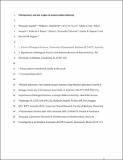Files in this item
Pluripotency and the origin of animal multicellularity
Item metadata
| dc.contributor.author | Sogabe, Shunsuke | |
| dc.contributor.author | Hatleberg, William L. | |
| dc.contributor.author | Kocot, Kevin M. | |
| dc.contributor.author | Say, Tahsha E. | |
| dc.contributor.author | Stoupin, Daniel | |
| dc.contributor.author | Roper, Kathrein | |
| dc.contributor.author | Fernandez-Valverde, Selene L. | |
| dc.contributor.author | Degnan, Sandie M. | |
| dc.contributor.author | Degnan, Bernard M. | |
| dc.date.accessioned | 2019-12-12T00:38:18Z | |
| dc.date.available | 2019-12-12T00:38:18Z | |
| dc.date.issued | 2019-06-12 | |
| dc.identifier | 259340991 | |
| dc.identifier | 464e0984-7c35-40f6-9ac8-d0dc31058b33 | |
| dc.identifier | 85067398120 | |
| dc.identifier | 000472860000050 | |
| dc.identifier.citation | Sogabe , S , Hatleberg , W L , Kocot , K M , Say , T E , Stoupin , D , Roper , K , Fernandez-Valverde , S L , Degnan , S M & Degnan , B M 2019 , ' Pluripotency and the origin of animal multicellularity ' , Nature . https://doi.org/10.1038/s41586-019-1290-4 | en |
| dc.identifier.issn | 1476-4687 | |
| dc.identifier.uri | https://hdl.handle.net/10023/19125 | |
| dc.description | Funding: This study was supported by funds from the Australian Research Council (B.M.D. and S.M.D.). | en |
| dc.description.abstract | A widely held—but rarely tested—hypothesis for the origin of animals is that they evolved from a unicellular ancestor, with an apical cilium surrounded by a microvillar collar, that structurally resembled modern sponge choanocytes and choanoflagellates1,2,3,4. Here we test this view of animal origins by comparing the transcriptomes, fates and behaviours of the three primary sponge cell types—choanocytes, pluripotent mesenchymal archaeocytes and epithelial pinacocytes—with choanoflagellates and other unicellular holozoans. Unexpectedly, we find that the transcriptome of sponge choanocytes is the least similar to the transcriptomes of choanoflagellates and is significantly enriched in genes unique to either animals or sponges alone. By contrast, pluripotent archaeocytes upregulate genes that control cell proliferation and gene expression, as in other metazoan stem cells and in the proliferating stages of two unicellular holozoans, including a colonial choanoflagellate. Choanocytes in the sponge Amphimedon queenslandica exist in a transient metastable state and readily transdifferentiate into archaeocytes, which can differentiate into a range of other cell types. These sponge cell-type conversions are similar to the temporal cell-state changes that occur in unicellular holozoans5. Together, these analyses argue against homology of sponge choanocytes and choanoflagellates, and the view that the first multicellular animals were simple balls of cells with limited capacity to differentiate. Instead, our results are consistent with the first animal cell being able to transition between multiple states in a manner similar to modern transdifferentiating and stem cells. | |
| dc.format.extent | 20 | |
| dc.format.extent | 8245722 | |
| dc.language.iso | eng | |
| dc.relation.ispartof | Nature | en |
| dc.subject | QH301 Biology | en |
| dc.subject | DAS | en |
| dc.subject.lcc | QH301 | en |
| dc.title | Pluripotency and the origin of animal multicellularity | en |
| dc.type | Journal article | en |
| dc.contributor.institution | University of St Andrews. Scottish Oceans Institute | en |
| dc.contributor.institution | University of St Andrews. School of Biology | en |
| dc.identifier.doi | 10.1038/s41586-019-1290-4 | |
| dc.description.status | Peer reviewed | en |
| dc.date.embargoedUntil | 2019-12-12 | |
| dc.identifier.url | https://www.biorxiv.org/content/10.1101/564518v1.article-info | en |
This item appears in the following Collection(s)
Items in the St Andrews Research Repository are protected by copyright, with all rights reserved, unless otherwise indicated.

